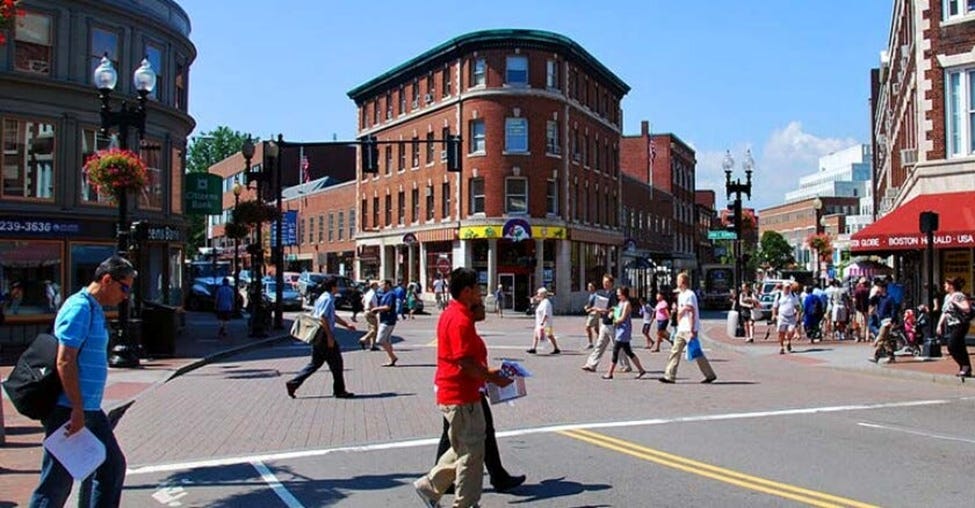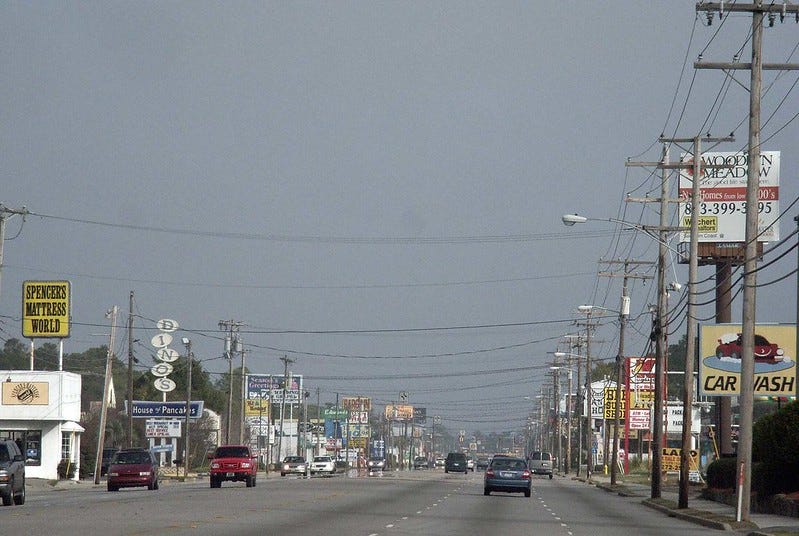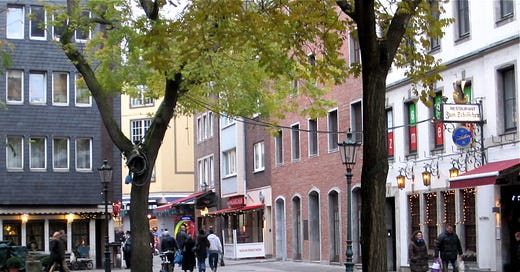By guest author Bryce Mitchell of Building Community.
Decades of car-centric infrastructure paired with clever marketing have closely intertwined cars with our perception of American freedom and our way of life. But point out to your fellow conservative any of the problems with building cities for cars instead of people, and you will not infrequently be met with scorn and pearl-clutching. This is despite the fact that traditional urbanism, which includes things like walkable, bikeable, and mixed-use development, naturally aligns with conservative thought. The objections I most frequently hear generally fall under three categories:
Reducing car dependency means forcefully taking people’s cars.
Cars are essential to the American way of life and freedom of movement.
Cars allow for living in safe suburbs away from dangerous cities.
The first objection is misguided. Confiscating cars is not the goal. Even the far left, which certainly is anti-car in many respects, still shills for electric cars. But for conservatives such as myself, taking away cars is not the goal. In a less car-dependent world, there would be fewer cars — not because of coercion, but because people could walk, bike, or use public transit if they choose to.
The second objection frequently includes a reference to America’s size. “America is too big — it needs cars!” There is some truth to these claims today, but fundamentally they are misguided as well. America is much older than the car, and it was still America before the car was invented. America spanned from sea to shining sea with the power of trains, not cars. American cities were then “bulldozed for the car” after World War II. Passenger trains fell out of favor not because they were somehow antithetical to American culture, but because the government built the Interstate Highway System, effectively subsidizing their demise. Subsequent infrastructure sprawled out to take advantage of the speed of the car and cheap land, which is why America is too spread out for any other mode of transportation besides cars. We’ve made cars a necessity, but it wasn’t always this way, and with a revival in traditional urbanism, it can quickly change.
This second objection also references the “freedom” of cars. The freedom a car offers is largely illusory. Don’t get me wrong — I love the thrill of accelerating quickly on an open road, but most of my time spent in a car is stuck in traffic. Cars offer freedom in rural areas, where they make sense as a form of transportation. But in urban environments, traffic is inescapable. There is simply no way to move large numbers of people efficiently with cars. For that, you need something approximating a train. Counterintuitively, adding more lanes increases traffic, due to induced demand (which I will not go into, but it is worth looking up). The Katy Freeway in Houston, for instance, has expanded to 26 lanes, but adding more lanes has only made traffic worse. Furthermore, it is a massive eyesore:
These road-widening projects are incredibly destructive. Despite the empirical evidence, traffic engineers still believe in adding more lanes. Hence the “90% of traffic engineers quit just one lane before finally fixing traffic” joke. If we continue on our current infrastructure path, you can expect freeways to widen, destroying homes, businesses, churches, and neighborhoods. All the while, the traffic gets worse due to induced demand.
There are other ways that car-centric developments limit our choices and cost us freedom. If you want to go somewhere, you usually have only one choice: take a car. For children, it is often too dangerous to walk or bike in a development built for cars. Your choices are to have an adult drive you around for hours in a car to activities, or to stay home. It also hurts small businesses by raising the cost of entry (think parking requirements) and by favoring large, one-stop shops over specialty businesses.
With a more traditional pattern of development, you can walk, bike, take public transit, or drive a car. Children can walk and bike to stores, cafés, and activities. Small businesses don’t need to pay for expensive parking requirements they don’t need. Fewer cars on the road mean safer roads with less traffic, so even people who choose to drive cars stand to benefit as well.
The third objection, that cars are necessary for living far from unsafe cities, is the strongest of the three. Yet, with this objection, there seems to be an implicit idea that promoting traditional urbanism requires rounding up people in suburbs and forcing them to live in slums, which is certainly not the case. Traditional urbanism would mean more of this:

And less of this:

Additionally, this kind of thinking also discounts how unsafe America’s car-centric infrastructure is. The U.S. has one of the highest rates of car fatalities in the developed world: 12.8 per 100,000. Compare that to Sweden’s 1.94 per 100,000, or Denmark’s 2.23 per 100,000 (data from 2022; see concentric circle chart here). The year 2022 saw the highest homicide rate in about 25 years, and yet it was only 7.5 per 100,000. While this is way higher than it should be in any developed country, it is much, much lower than car fatalities. If safety is your objection, there is a huge opportunity to save thousands of lives by adopting more traditional urban designs like Sweden or Denmark. Even dropping it in half to a still-high 6.4 (about the rate of New Zealand) would result in saving more than 20,000 lives per year.
Conservatives should be more skeptical of cars. For some reason, normal conservative principles and sentiments seem to go out the window in discussions involving cars. They are something of a sacred cow, but it was not this way in the past. Tolkien famously strongly disliked the internal combustion engine. And other figures such as Peter Hitchens have their reservations about the automobile. I suspect there will be a shift, and conservatives will adopt a more conservative view of cars and car-centric urbanism. I have already seen the shift in people my age. And it cannot be stressed enough that it would improve the experience of car drivers. Because it separates bikes and pedestrians from cars, they compete less for space, and because fewer cars overall mean less traffic and less wear and tear on the roads, the result would be better conditions for driving cars. Cars, like most good things, are best in moderation. While by no means a silver bullet, a revival of traditional urbanism would be truly beneficial for America and our society.







Making American cities beautiful again means making American cities human again. Great piece.
.
Love this, need more of it. You leave out two other points that should resonate more with conservatives:
1 - Financial sustainability: Every agency that maintains roadways is going broke. Partly because we built so much new infrastrucure and care so little about our future maintenance obligations, but also because municipal accounting considers all transportation facilities to be asset with depreciating value. In reality they are liabilities that must be paid in the form of future maintenance obligations (the revenues to offset need to be created by either the adjacent economic activity that the road provides access to or collectes from users via a toll or similar).
2 - Federal Government Intervention: The land use pattern that we are saddled with is a product of the 1926 Supreme Court case Euclid v Ambler which established that municipal zoning was a valid use of the police power (to protect public health, safety, and welfare) and subsequently resulted in the profileration of zoning ordinances that restrict what type of use can go where within a municipal boundary. If you wanted to construct a live/work situation with a ground floor business, you could only do so in the designated zoning district, which to my knowledge were extremely limited in area at the time. Follow this up with the federal governments role in the housing marking with Fannie Mae/Freddy Mac only insuring the home loans for single family houses, it became even more challenging to secure financing for what was previously the dominant, traditional development pattern. The interstate system and the federal government funding of highway projects after WWII was just the final nail in the coffin.
I can only assume you've heard of Strong Towns and Chuck Mahron, but I'd you haven't look them up.